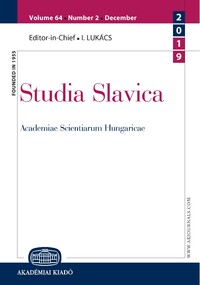Достоевский, Аполлон Григорьев, Бахтин
Dostoevsky, Apollon Grigoriev, and Bakhtin
Author(s): Sergei Shul'tsSubject(s): Russian Literature
Published by: Akadémiai Kiadó
Keywords: Dostoevsky; Apollon Grigoriev; Bakhtin; Kant; art and life; polyphony; carnivalization; Sentimentalism; Romanticism
Summary/Abstract: Apollon Grigoriev and Bakhtin touched upon quite different issues of Dostoevsky’s work but the correlation between their works is obvious at the level of their metalogic, their philosophy, and their cultural-philosophical foundations. Grigoriev, together with Dostoevsky, was at the origins of “pochvennichestvo” (a grassroots movement), although Grigoriev’s comments on Dostoevsky’s work are episodic and rather injective. Grigoriev basically denied Dostoevsky that his art corresponded to the “truth of life”. But even the first version of Bakhtin’s book about Dostoevsky was not apologetic. Grigoriev and Bakhtin realize their philosophy through aesthetics (philosophy of art). Art, according to Grigoriev, has its origins in life itself, and life through art realizes itself and understands itself; therefore the critic is also an “artist”. Bakhtin also proceeds from the principle of correlation between art and life, deriving from this his concept of “creative chronotope”. Grigoriev, Bakhtin, and Dostoevsky deal with the ontology of art as well as the art of ontology. The art of ontology implies the broadest aestheticization of life: its movement into the horizon of art. This attitude is pre-modern and modern. In the genesis of the concept of “organic criticism”, the lessons of Kant as the author of three philosophical “Critics” could be echoed. Kant’s ideas were also significant for Dostoevsky and Bakhtin. Grigoriev might have been interested in the philosophical dimension that Kant gave to the concept of “criticism”. Therefore, “organic criticism” refers primarily to philosophy, raising a voluminous list of issues that exceed the aesthetic ones themselves. According to Bakhtin, Dostoevsky’s polyphony consists in the fact that the author acts as a “medium”, “passing” various ideas through himself (“voices” of characters, different “points of view”, etc.). The author- medium “conducts” “through himself” and “out of myself” a lot of different ideas without the essential rejection of any of them. The “author-medium” tries to speak on behalf of life but also even “instead of life”, which leads to a logical and semantic substitution of “the world” – “an image of the world”. Essential rejection does not at all mean that the author has no formal rejection, i.e. just stated. Essential non-rejection, however, means much more than any formal rejection. Life, historical being in this case turns out to be practically “chaos” for Dostoevsky. In the development of Bakhtin’s ideas, it follows that, when introducing carnivalization into his artistic world, Dostoevsky affirms a “link” of sensitivity / physiology. The origins of this “link” are in the sentimentalism of the 18th century. This “link” finds a religious projection in the phenomenon of “yurodstvo” (foolishness). Therefore, Bakhtin’s final interpretation of Dostoevsky (1963) is driven by the pathos of the “justification” of the writer, whose integrity of the artistic world is mainly realized through the religious “image of the world” (aft er all, the “image of the world” and not the “world” itself).
Journal: Studia Slavica Academiae Scientiarum Hungaricae
- Issue Year: 65/2020
- Issue No: 1
- Page Range: 193-207
- Page Count: 15
- Language: Russian
- Content File-PDF

